Exploring the Legacy of A P J Abdul Kalam – A Brief History

History of A P J Abdul Kalam – Avul Pakir Jainulabdeen Abdul Kalam, commonly known as A.P.J. Abdul Kalam, was an Indian scientist and politician who served as the 11th President of India from 2002 to 2007. He was born on October 15, 1931, in Rameswaram, Tamil Nadu, India.
Kalam was the youngest of four siblings and grew up in a modest family. His father was a boat owner who ferried pilgrims between Rameswaram and the Dhanushkodi coast, and his mother was a housewife. Despite his family’s financial struggles, Kalam was a diligent student who excelled in science and mathematics.
After completing his studies in aerospace engineering from the Madras Institute of Technology, Kalam joined the Defence Research and Development Organisation (DRDO) in 1958. He played a key role in the development of India’s first satellite launch vehicle, the SLV-III, and also contributed to the development of the country’s first nuclear tests.
Kalam’s contributions to India’s defence research and technology earned him several awards and honours, including the Padma Bhushan, Padma Vibhushan, and Bharat Ratna, which is India’s highest civilian honour.
In 2002, Kalam was elected as the President of India. During his tenure, he became known as the “People’s President” for his humble and approachable demeanor. He also worked to promote education and innovation in India, and inspired many young people to pursue careers in science and technology.
After his presidency, Kalam continued to be an influential figure in India, serving as a visiting professor at several universities and working to promote education and research in science and technology. He passed away on July 27, 2015, while delivering a lecture at the Indian Institute of Management Shillong. His death was widely mourned, and he is remembered as one of India’s greatest scientists and leaders.
A Closer Look at Abdul Kalam’s Family & Life Struggles
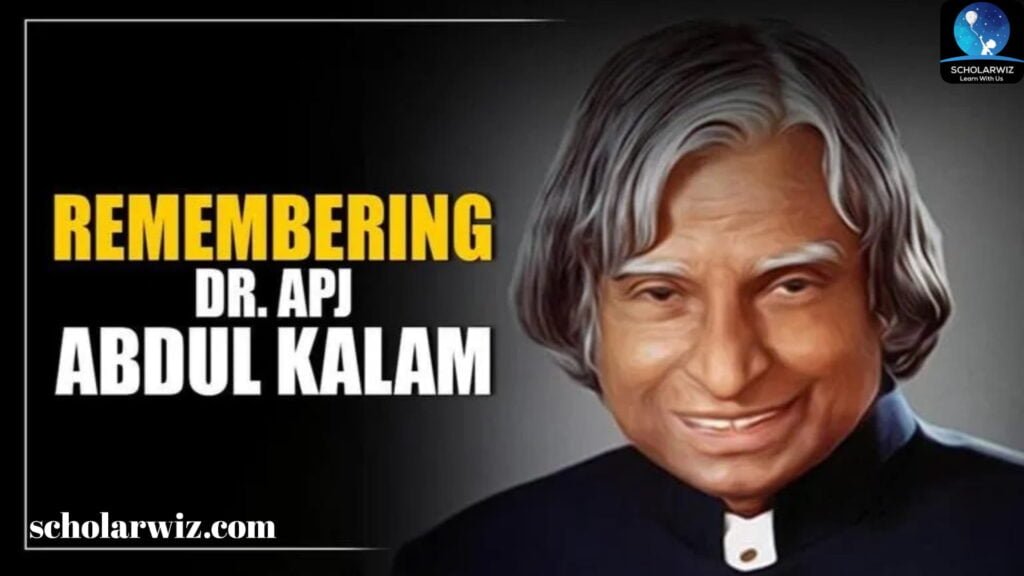
A.P.J. Abdul Kalam was born into a Tamil Muslim family in Rameswaram, Tamil Nadu, India. His father, Jainulabdeen, was a boat owner and his mother, Ashiamma, was a housewife. Kalam was the youngest of four siblings and had one elder brother and two elder sisters.
Kalam’s family was not well-off financially, and he had to work from a young age to support his studies. He sold newspapers as a child and later worked as a clerk in a temple to earn money. Despite these challenges, Kalam was a diligent student and excelled in his studies, particularly in science and mathematics.
After completing his studies in aerospace engineering, Kalam joined the Defence Research and Development Organisation (DRDO) in 1958. He faced several challenges in his early career, including working with limited resources and dealing with bureaucratic hurdles. However, he persevered and made significant contributions to India’s defence research and technology.
Despite his many accomplishments, Kalam remained humble and approachable throughout his life. He was known for his simple lifestyle and his dedication to promoting education and innovation in India. He often spoke to young people and inspired them to pursue careers in science and technology.
Kalam’s life and career are a testament to his hard work, perseverance, and commitment to public service. He is remembered as a great scientist, leader, and role model, both in India and around the world.
A Look Into A P J Abdul Kalam’s Education History and Legacy
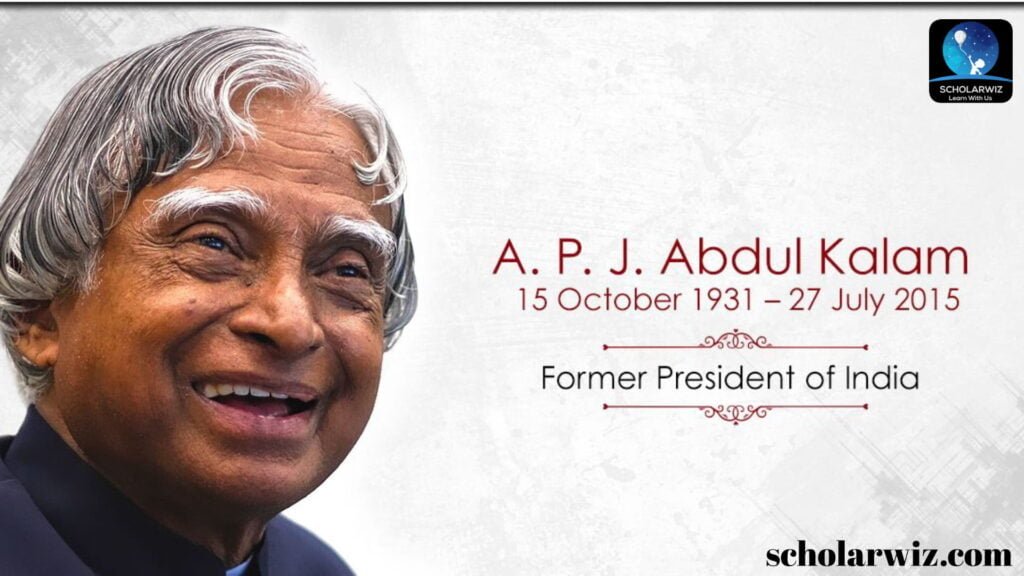
A.P.J. Abdul Kalam had a remarkable educational background that laid the foundation for his successful career in science and technology. He started his schooling at the Rameswaram Elementary School, and later attended the Schwartz High School in Ramanathapuram.
After completing his secondary education, Kalam enrolled in St. Joseph’s College in Tiruchirappalli, where he studied physics. However, he faced financial difficulties and had to support himself through college by selling newspapers.
After completing his Bachelor’s degree, Kalam moved to Madras (now Chennai) to study aerospace engineering at the Madras Institute of Technology (MIT). He completed his Master’s degree in aerospace engineering in 1958.
Kalam continued his education at the Defence Research and Development Service (DRDS) in the United Kingdom, where he earned a Master of Science degree in 1960 and a PhD in Aerospace Engineering in 1965.
Throughout his educational career, Kalam was a diligent and hardworking student who excelled in his studies. His academic achievements laid the foundation for his successful career in science and technology, and he went on to make significant contributions to India’s space and defence programs.
What Was A P J Abdul Kalam Known For?

A P J Abdul Kalam was famous for his contributions to India’s space and defence programs, as well as for his role as the 11th President of India. Here are some of his notable accomplishments:
- Contributions to India’s Space and Defence Programs: Kalam played a key role in the development of India’s first satellite launch vehicle, the SLV-III, as well as the country’s first nuclear tests. He was also involved in the development of several other missile systems, including the Agni and Prithvi missiles.
- Vision 2020: Kalam was known for his vision of making India a developed country by the year 2020. He believed that this could be achieved through a focus on education, innovation, and technology.
- Role as President of India: Kalam was elected as the President of India in 2002 and served in this role until 2007. He was known as the “People’s President” for his approachable demeanor and his efforts to promote education and innovation in India.
- Author: Kalam was also a prolific author, and wrote several books on a range of topics, including science, technology, and spirituality. His most famous book, “Wings of Fire,” is an autobiography that chronicles his life and career.
- Inspiration to Youth: Kalam was an inspiration to millions of young people in India and around the world. He often spoke to students and encouraged them to pursue careers in science and technology, and to work towards a better future for themselves and their communities.
Overall, A.P.J. Abdul Kalam was famous for his contributions to science and technology, his vision for India’s future, and his role as a leader and inspiration to millions of people.
What are the important facts about A P J Abdul Kalam?

Here are some important facts about A.P.J. Abdul Kalam:
- A.P.J. Abdul Kalam was born on October 15, 1931, in Rameswaram, Tamil Nadu, India, and passed away on July 27, 2015, in Shillong, Meghalaya, India.
- Kalam was a scientist, engineer, and politician, and is known for his contributions to India’s space and defence programs, as well as for his role as the 11th President of India.
- Kalam earned degrees in physics and aerospace engineering, and later worked for the Defence Research and Development Organisation (DRDO) and the Indian Space Research Organisation (ISRO).
- Kalam played a key role in the development of India’s first satellite launch vehicle, the SLV-III, as well as the country’s first nuclear tests. He was also involved in the development of several other missile systems, including the Agni and Prithvi missiles.
- Kalam was elected as the President of India in 2002 and served in this role until 2007. He was known as the “People’s President” for his approachable demeanor and his efforts to promote education and innovation in India.
- Kalam was a prolific author, and wrote several books on a range of topics, including science, technology, and spirituality. His most famous book, “Wings of Fire,” is an autobiography that chronicles his life and career.
- Kalam was a vegetarian and was known for his simple and frugal lifestyle. He often spoke to young people and encouraged them to pursue careers in science and technology.
Overall, A P J. Abdul Kalam was a remarkable individual who made significant contributions to science, technology, and public service, and inspired millions of people around the world.
Life of A P J Abdul Kalam as a scientist?

A.P.J. Abdul Kalam had a distinguished career as a scientist, and made significant contributions to India’s space and defence programs. Here are some key highlights from his life as a scientist:
- Early Career: After completing his PhD in Aerospace Engineering from the Defence Research and Development Service (DRDS) in the United Kingdom, Kalam returned to India in 1960 and joined the DRDO as a scientist. He worked on several important projects, including the design and development of India’s first indigenous satellite launch vehicle, the SLV-III.
- Missile Development: In 1983, Kalam was appointed as the Chief Executive of the Integrated Guided Missile Development Programme (IGMDP), which aimed to develop a range of missile systems for India’s defence needs. Under Kalam’s leadership, the IGMDP developed several successful missile systems, including the Agni and Prithvi missiles.
- Nuclear Tests: Kalam played a key role in India’s nuclear weapons program, and was closely involved in the country’s first nuclear tests in 1998. He argued that India needed to develop nuclear weapons to ensure its security, and saw the tests as a way to assert India’s status as a global power.
- Awards and Recognition: Kalam’s contributions to science and technology were recognized with several awards and honors throughout his career. He was awarded the Padma Bhushan in 1981, the Padma Vibhushan in 1990, and the Bharat Ratna in 1997, which is India’s highest civilian honor.
Overall, A.P.J. Abdul Kalam’s (history of a p j abdul kalam) life as a scientist was marked by his innovative ideas, his dedication to India’s defence and space programs, and his contributions to missile development and nuclear technology. His work has had a lasting impact on India’s scientific and technological capabilities.
How A.P.J. Abdul Kalam Impacted the Presidency in India
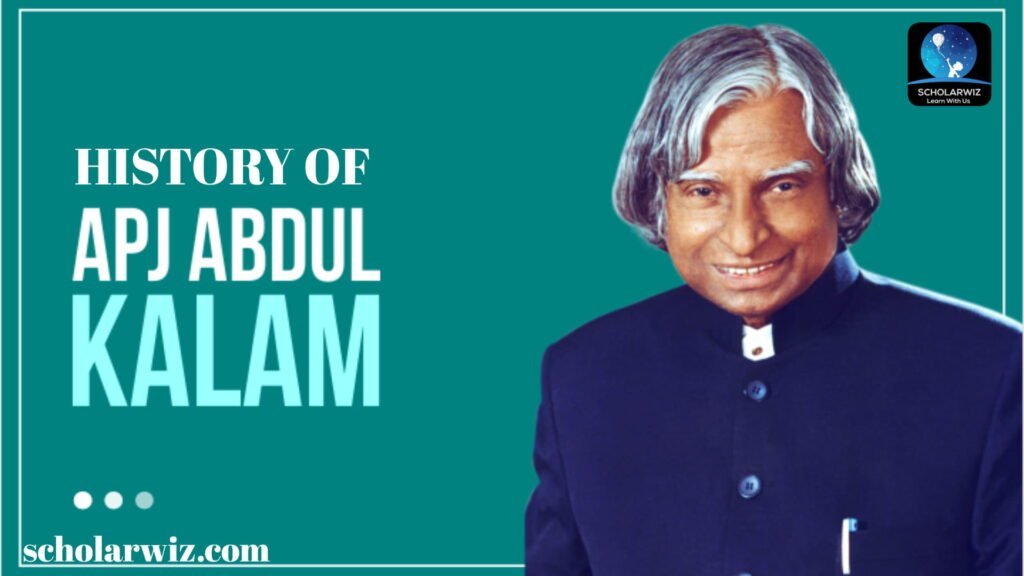
A.P.J. Abdul Kalam served as the 11th President of India from 2002 to 2007. Here are some key highlights from his life as President:
- Election as President: In 2002, Kalam was nominated as a candidate for the President of India by the ruling Bharatiya Janata Party (BJP) and the opposition Indian National Congress party. He won the presidential election with an overwhelming majority.
- People’s President: Kalam was known as the “People’s President” for his approachable and humble demeanor. He made efforts to connect with ordinary people, especially young people, and encouraged them to pursue their dreams and aspirations.
- Promotion of Education: Kalam was a strong advocate for education, and used his position as President to promote education and literacy in India. He launched several initiatives, including the PURA (Providing Urban Amenities in Rural Areas) scheme, which aimed to provide basic amenities and infrastructure in rural areas.
- International Relations: As President, Kalam played an important role in shaping India’s foreign policy. He made efforts to strengthen India’s ties with other countries, including the United States, and worked to promote peace and cooperation in South Asia.
- Continued Writing: Despite his busy schedule as President, Kalam continued to write and publish books. His books focused on a range of topics, including spirituality, education, and youth empowerment.
- End of Presidency: At the end of his term as President in 2007, Kalam decided not to seek re-election. He returned to a private life but remained an important public figure, continuing to inspire people with his message of hope and perseverance.
Overall, A.P.J. Abdul Kalam’s life as President was marked by his commitment to education, his efforts to promote peace and cooperation, and his vision for a better India. He remains a beloved and respected figure in Indian politics and society.
Remembering A P J Abdul Kalam: The Author Who Inspired Millions
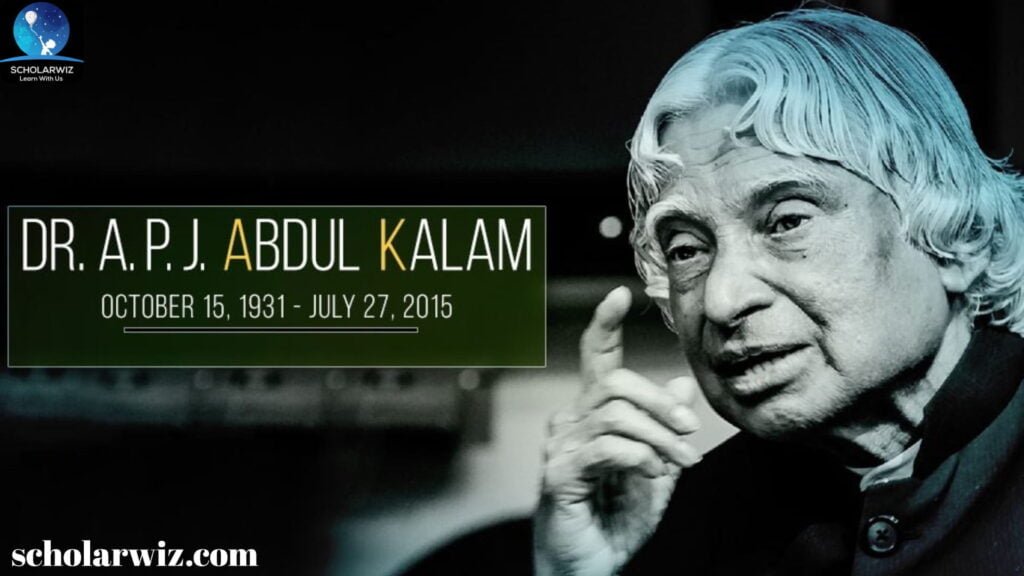
A.P.J. Abdul Kalam was a prolific author and wrote many books throughout his life. Here are some key facts about his writing:
- Range of Topics: Kalam wrote about a wide range of topics, including science, spirituality, education, and leadership. He often combined his scientific and technical knowledge with his spiritual beliefs to offer unique insights into these topics.
- Popular Books: Kalam’s books were widely popular in India and around the world. Some of his most famous books include “Wings of Fire,” an autobiography that traces his journey from a small town in South India to becoming a prominent scientist, and “Ignited Minds,” which focuses on the need to inspire and empower India’s youth.
- Inspiration for Youth: Kalam’s books were particularly popular among young people, and he was known for his ability to inspire and motivate them. Many of his books offered practical advice and guidance for young people looking to pursue careers in science, technology, and other fields.
- Awards and Recognition: Kalam’s writing was widely recognized, and he received several awards and honors for his books. In 2003, he was awarded the Ramanujan Award for his contributions to science and education, and in 2011, he received the Padma Bhushan posthumously for his contributions to literature and education.
Overall, A.P.J. Abdul Kalam’s writing was an important part of his legacy. His books continue to inspire and motivate people around the world, and his unique perspective on science, spirituality, and leadership has had a lasting impact on many people’s lives.
A List of the Most Iconic Books Written by A. P. J Abdul Kalam
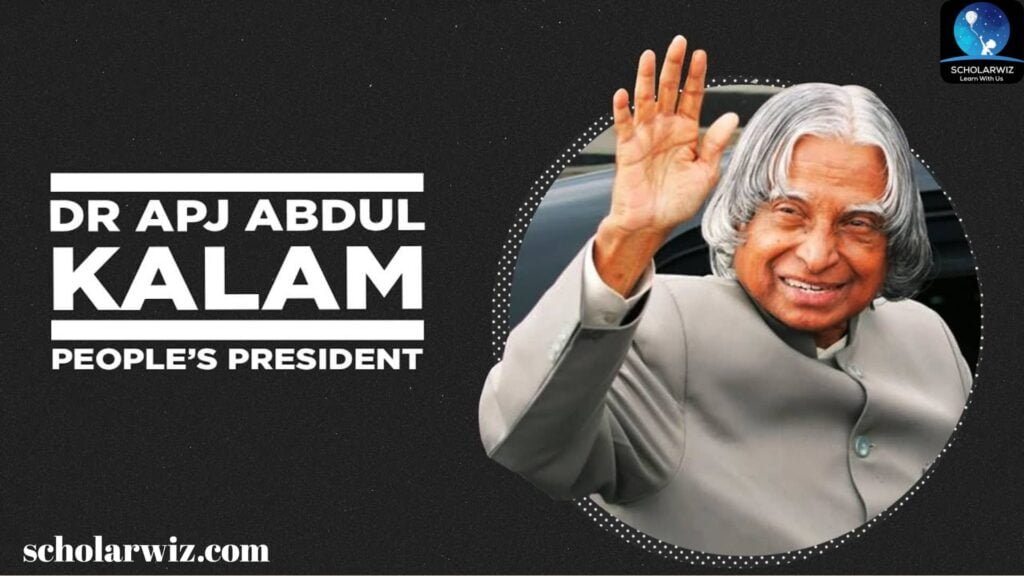
A.P.J. Abdul Kalam (history of a p j abdul kalam) was a prolific author who wrote several books throughout his life. Here are some of his most famous books:
- Wings of Fire: An Autobiography: This book is an autobiographical account of Kalam’s life, from his childhood in a small town in South India to his work as a scientist and his tenure as the President of India. It is widely regarded as one of his most popular and inspiring works.
- Ignited Minds: Unleashing the Power Within India: In this book, Kalam discusses the need to inspire and empower India’s youth, and offers practical guidance on how to achieve this. He argues that India can become a developed nation by harnessing the power of its young people.
- My Journey: Transforming Dreams into Actions: This book is a collection of Kalam’s speeches and lectures, in which he shares his experiences and offers guidance on how to achieve success in life. It is aimed at young people and offers practical advice on how to achieve their goals.
- The Luminous Sparks: This book is a collection of Kalam’s poems, in which he explores a range of themes, from love and spirituality to science and nature. It offers a unique insight into Kalam’s creative and spiritual side.
- India 2020: A Vision for the New Millennium: In this book, Kalam presents his vision for India’s future, and outlines a roadmap for achieving it. He argues that India can become a developed nation by harnessing its strengths in science and technology.
These are just a few examples of A.P.J. Abdul Kalam’s most famous books. He was a prolific author who wrote on a wide range of topics, and his books continue to inspire and motivate people around the world.
Why Did Atal Bihari Vajpayee Call Abdul Kalam ‘Missile Man’?

A.P.J. Abdul Kalam was known as the “Missile Man of India.” The nickname was given to him in the 1990s by Atal Bihari Vajpayee when he was working on India’s missile program and made significant contributions to the development of ballistic missile technology. Kalam’s work in this field was widely recognized and helped establish India as a major player in the field of missile technology.
Why A P J Abdul Kalam is an inspiration?
A.P.J. Abdul Kalam is widely regarded as an inspiration for several reasons. Here are a few of them:
- Humble beginnings: Kalam grew up in a small town in South India and came from a very humble background. Despite this, he worked hard and pursued his education, eventually becoming one of India’s most prominent scientists.
- Dedication to education: Kalam was deeply committed to education and worked tirelessly to inspire and empower India’s youth. He believed that education was the key to India’s future success, and devoted much of his life to this cause.
- Scientific contributions: Kalam was a prominent scientist who made significant contributions to India’s missile program and helped establish the country as a major player in the field of missile technology. He was also known for his work in space technology and his contributions to India’s civilian nuclear program.
- Vision for India’s future: Kalam had a clear vision for India’s future and worked tirelessly to make it a reality. He believed that India could become a developed nation by harnessing the power of its young people and its strengths in science and technology.
- Positive attitude: Kalam was known for his positive attitude and his ability to inspire and motivate others. He believed in the power of hard work and perseverance, and his life story serves as a testament to this.
History of A P J Abdul Kalam – Overall, A.P.J. Abdul Kalam is an inspiration because of his dedication to education, his scientific contributions, his vision for India’s future, and his positive attitude. He continues to inspire and motivate people around the world, and his legacy lives on through his writing, speeches, and the institutions he helped establish.
A Piece of History: Top 5 Famous Speeches by A P J Abdul Kalam
A.P.J. Abdul Kalam was known for his powerful and inspiring speeches. Here are five of his most famous speeches:
- “Youth and Nation Building” (2001): In this speech, Kalam emphasized the importance of youth in building a strong and prosperous nation. He urged young people to embrace education, work hard, and contribute to their communities.
- “Creating a World Without Boundaries” (2002): In this speech, Kalam discussed the importance of breaking down barriers between people and nations. He emphasized the need for cooperation and collaboration in order to achieve global peace and prosperity.
- “My Vision of India in 2020” (1998): In this speech, Kalam presented his vision for India’s future and outlined a roadmap for achieving it. He argued that India could become a developed nation by harnessing its strengths in science and technology.
- “Role of Science in National Development” (2009): In this speech, Kalam emphasized the importance of science and technology in driving economic development and improving the quality of life for people around the world.
- “Education for Sustainable Development” (2004): In this speech, Kalam discussed the importance of education in promoting sustainable development. He emphasized the need for education to be accessible and inclusive, and for young people to be empowered to make a positive impact on their communities and the world.
These are just a few examples of A.P.J. Abdul Kalam’s most famous speeches. He was a gifted orator who inspired and motivated people around the world with his vision, wisdom, and positive attitude.
When and how did A.P.J. Abdul Kalam enter politics?
A.P.J. Abdul Kalam entered politics in 2002, when he was nominated for the position of President of India by the ruling National Democratic Alliance (NDA) coalition government. Kalam was widely regarded as a non-political figure, as he had spent most of his career as a scientist and educator. However, his contributions to India’s missile and space programs had made him a national icon, and his nomination was widely welcomed by politicians and the public alike.
Kalam won the presidential election with an overwhelming majority, and served as India’s President from 2002 to 2007. During his time in office, he continued to focus on issues related to education, youth empowerment, and national development. He was widely respected for his integrity, humility, and commitment to public service, and his tenure as President is widely regarded as a period of stability and progress for India.
It is worth noting that the position of President in India is largely ceremonial, and the President does not have executive powers or political affiliations. However, Kalam’s presidency was notable for his efforts to inspire and motivate young people, and for his commitment to promoting scientific research and development in India.
How many awards did A P.J Abdul Kalam received?
A.P.J. Abdul Kalam received numerous awards and honors throughout his career, in recognition of his contributions to science, technology, and public service. Here are some of the major awards and honors that he received:
- Padma Bhushan (1981)
- Padma Vibhushan (1990)
- Bharat Ratna (1997)
- Veer Savarkar Award (1998)
- Ramanujan Award (2000)
- King Charles II Medal (2007)
- Hoover Medal (2008)
- International von Kármán Wings Award (2009)
- Doctor of Laws (Honoris Causa) from 30 universities worldwide
- Honorary Fellow of the Indian Institute of Science, Bangalore
In addition to these awards, Kalam also received numerous honorary doctorates, awards, and accolades from universities, organizations, and governments around the world. His contributions to science, technology, and public service continue to inspire and motivate people around the world, and his legacy as one of India’s greatest sons will continue to be celebrated for generations to come.
Abdul Kalam’s Death
Abdul Kalam passed away on July 27, 2015, while delivering a lecture on “Livable Planet” to students at the Indian Institute of Management Shillong. He collapsed while speaking, and was immediately taken to the hospital, where he was pronounced dead due to a cardiac arrest.
Kalam’s death was a great loss to India and the world, as he was widely regarded as a visionary leader and an inspiration to millions of people. His funeral was attended by dignitaries from across India and around the world, including the President, Prime Minister, and other leaders.
Despite his passing, Kalam’s legacy continues to inspire people around the world. He is remembered for his contributions to science, technology, and public service, as well as his humble and down-to-earth personality. His life and work continue to be celebrated through numerous awards, scholarships, and other initiatives in his honor.
What we can learn from A P J Abdul Kalam
There are many lessons that we can learn from the life and work of A.P.J. Abdul Kalam. Here are a few key lessons that stand out:
- Hard work and perseverance: Kalam was known for his tireless work ethic and dedication to his goals. He believed in setting high goals for himself and working hard to achieve them, and his life and work are a testament to the power of hard work and perseverance.
- The importance of education: Kalam believed that education was the key to unlocking India’s potential, and he worked tirelessly to promote education and scientific research throughout his career. He believed that education was the foundation for personal growth and social development, and his commitment to education has inspired millions of people around the world.
- Humility and service: Kalam was known for his humble and down-to-earth personality, and he believed in the power of service to others. He often spoke about the importance of serving others and using one’s talents for the betterment of society, and his life and work are a testament to the power of humility and service.
- Innovation and creativity: Kalam was a visionary leader who believed in the power of innovation and creativity to solve complex problems. He was instrumental in the development of India’s missile and space programs, and his contributions to science and technology continue to inspire people around the world.
- Overcoming adversity: Kalam overcame many challenges and setbacks in his life, including poverty and discrimination, to become one of India’s most respected leaders. His life and work are a testament to the power of perseverance and resilience, and his example can inspire us to overcome our own challenges and obstacles in life.
Final Words on A P J abdul kalam
A.P.J. Abdul Kalam was a visionary leader, a great scientist, and a humble human being who dedicated his life to the service of his country and humanity. He believed in the power of education, innovation, and hard work to transform society and improve people’s lives. His contributions to science and technology have made him a role model for people around the world, and his legacy continues to inspire us to work towards a better future for all.
History of A P J Abdul Kalam – Kalam’s life and work are a testament to the power of perseverance, resilience, and service, and his example can inspire us to live our lives with purpose and passion. He believed in the importance of giving back to society, and his contributions to education and social development continue to impact people’s lives in countless ways.
In the words of Kalam himself, “Dream, dream, dream. Dreams transform into thoughts and thoughts result in action.” Let us all be inspired by his example to dream big, work hard, and make a positive difference in the world.
An Introduction to the History of World War 2
A Brief History of the Ancient Practice of Yoga
About Ancient History of India: A Brief History
History of Taj Mahal – From Construction to Its Historical Significance.







